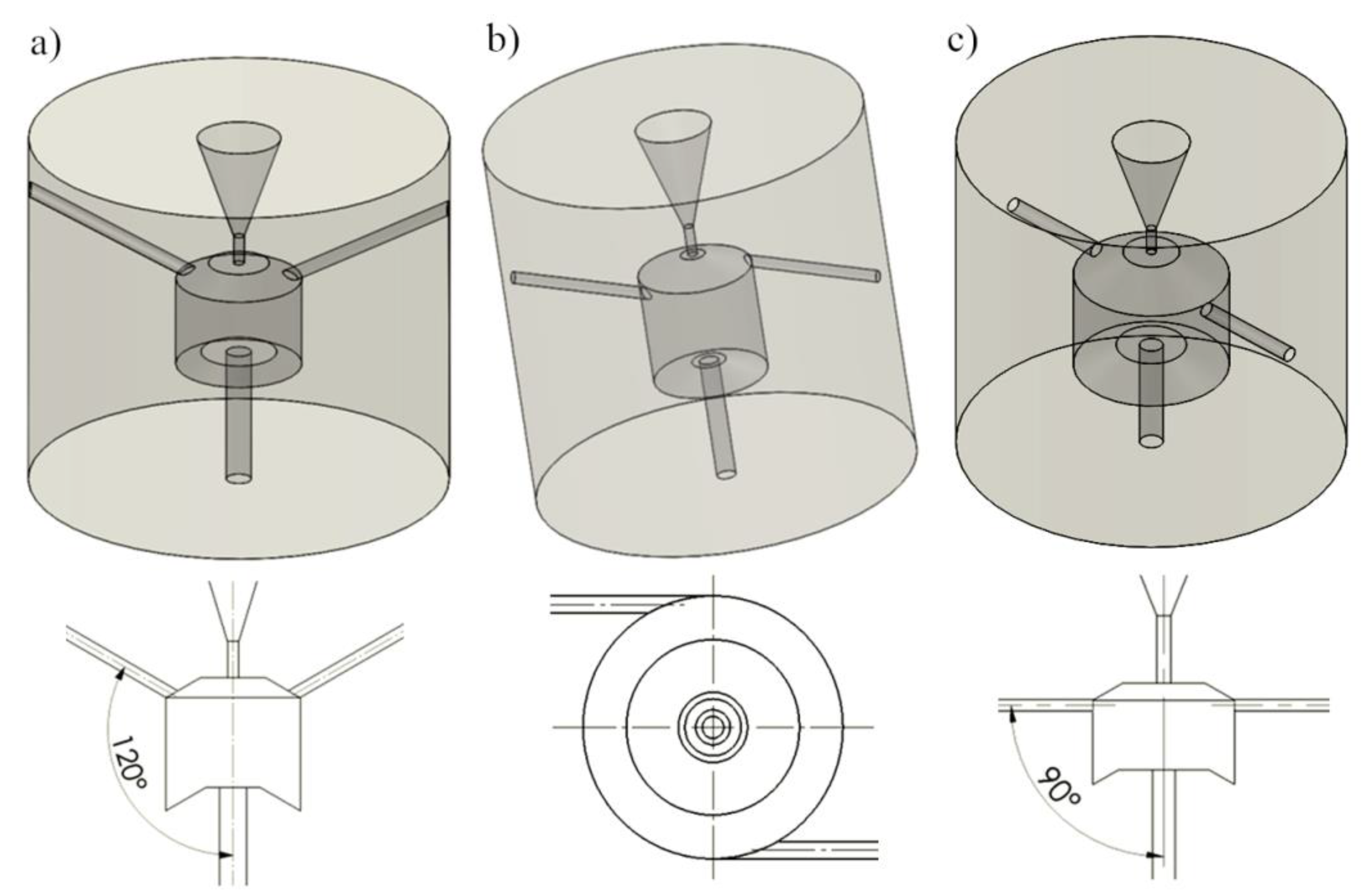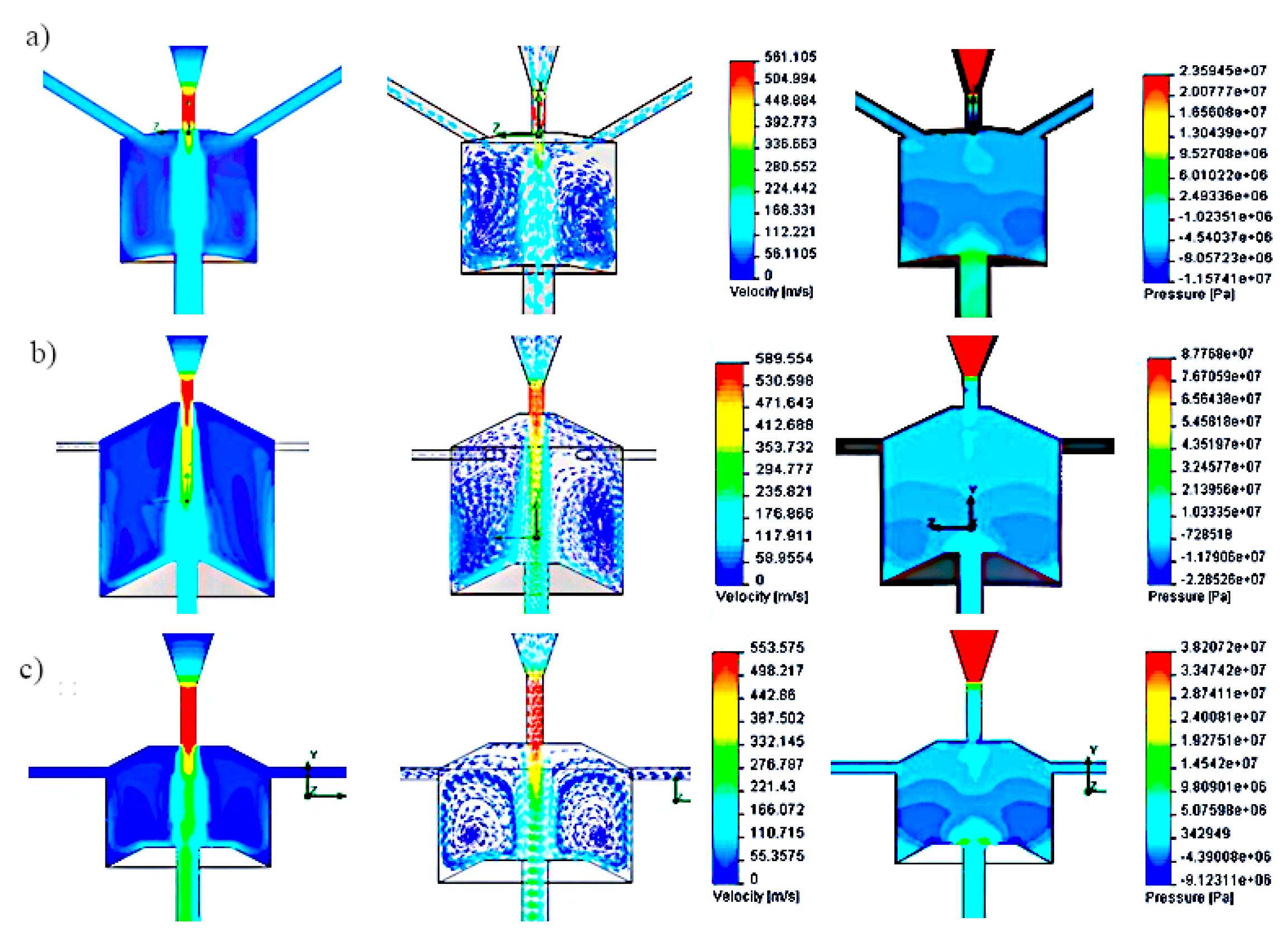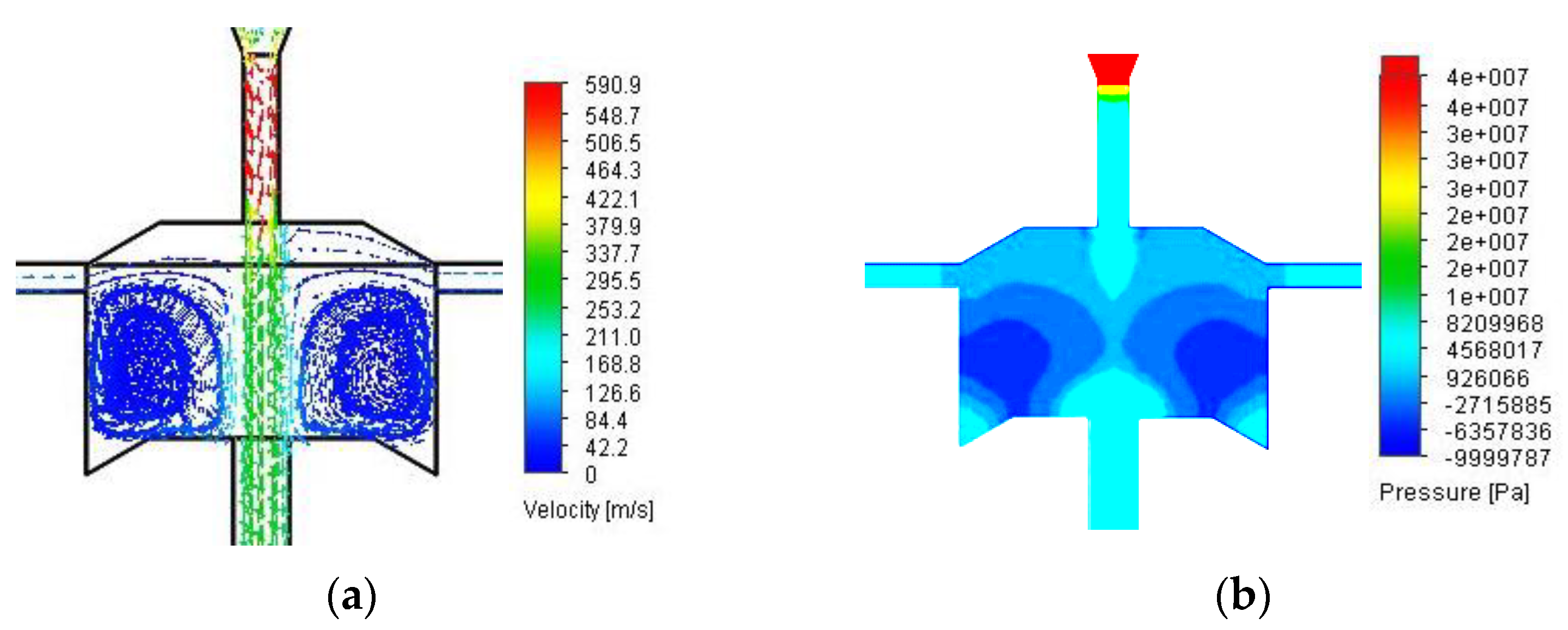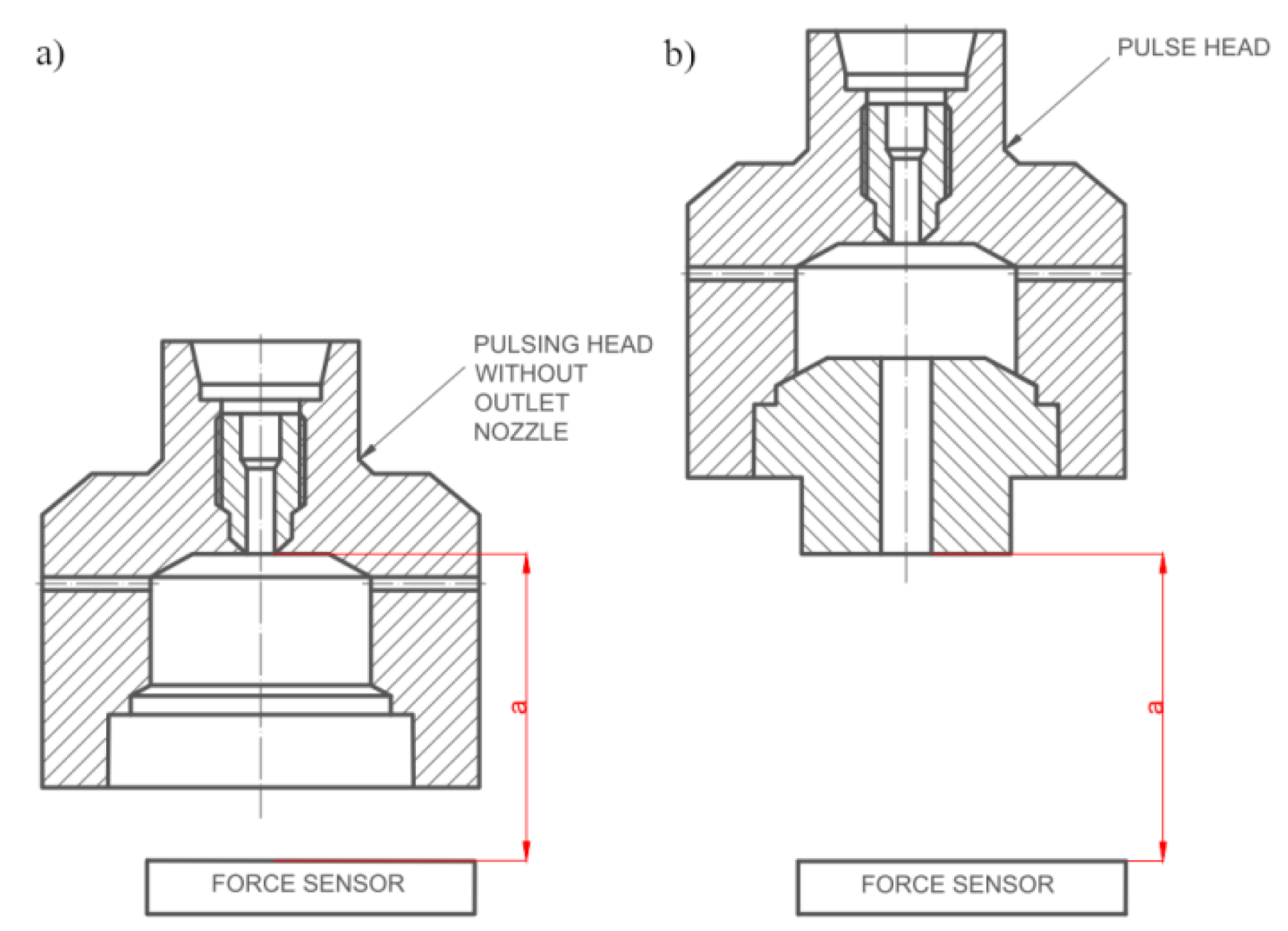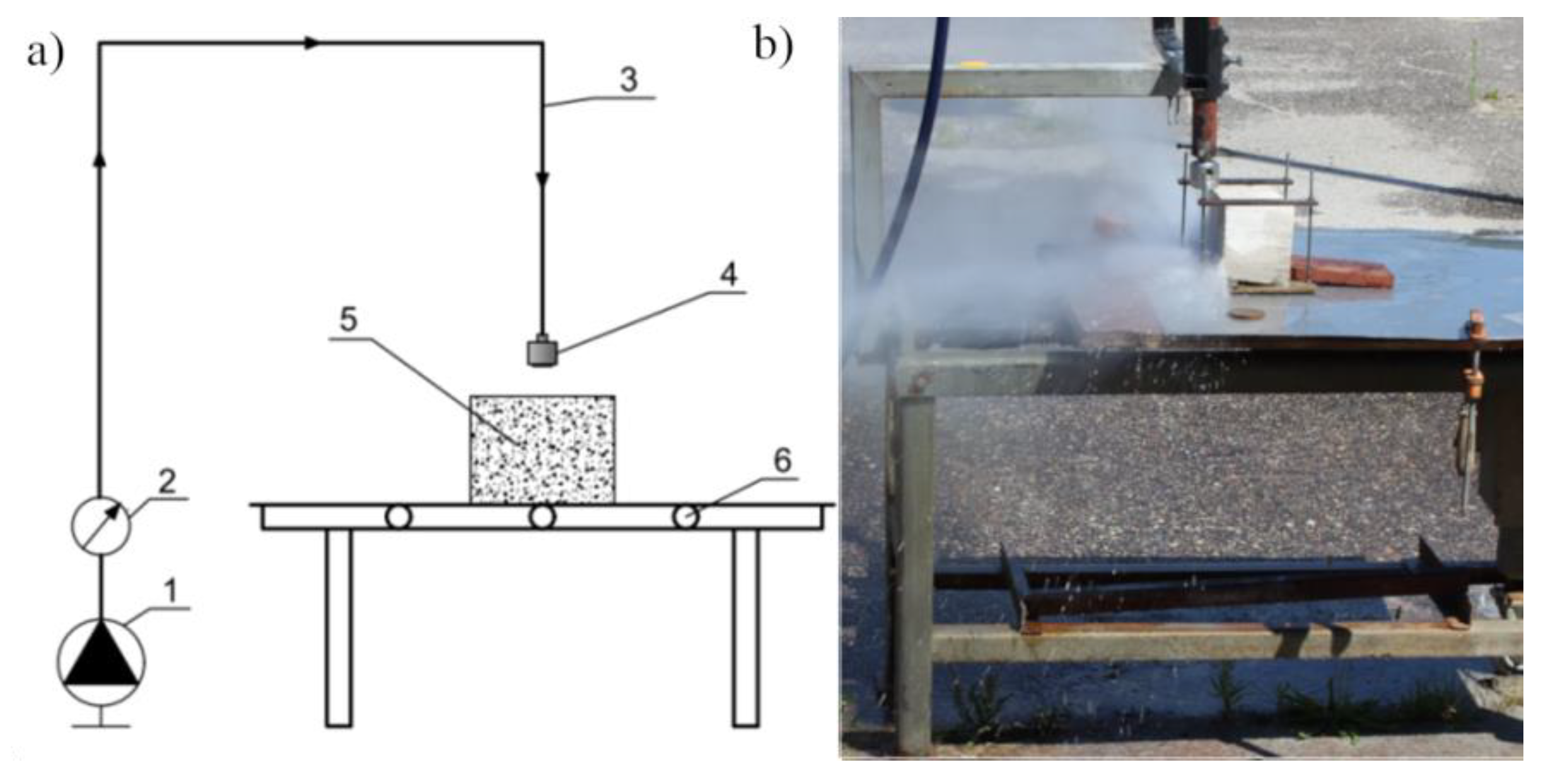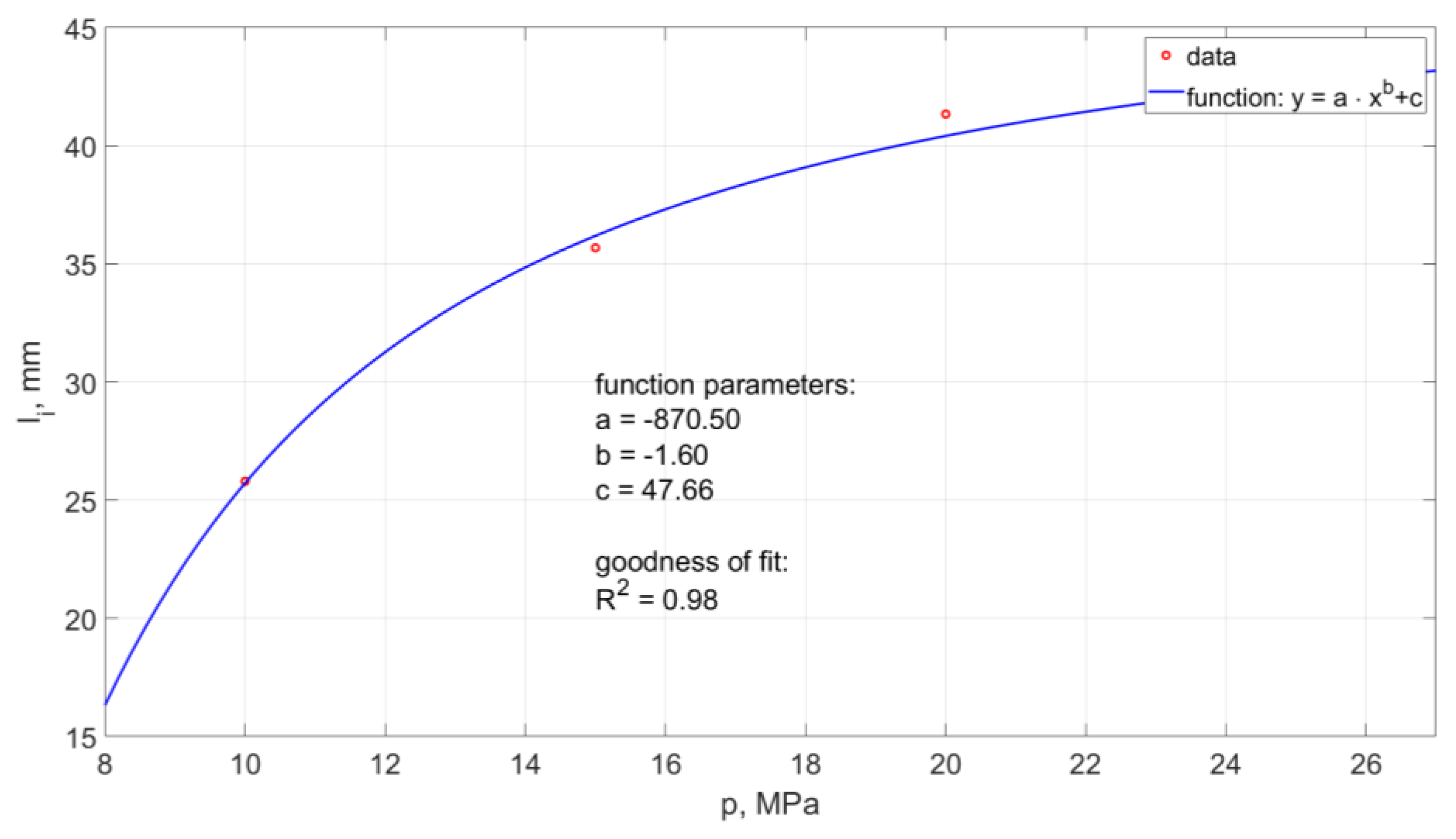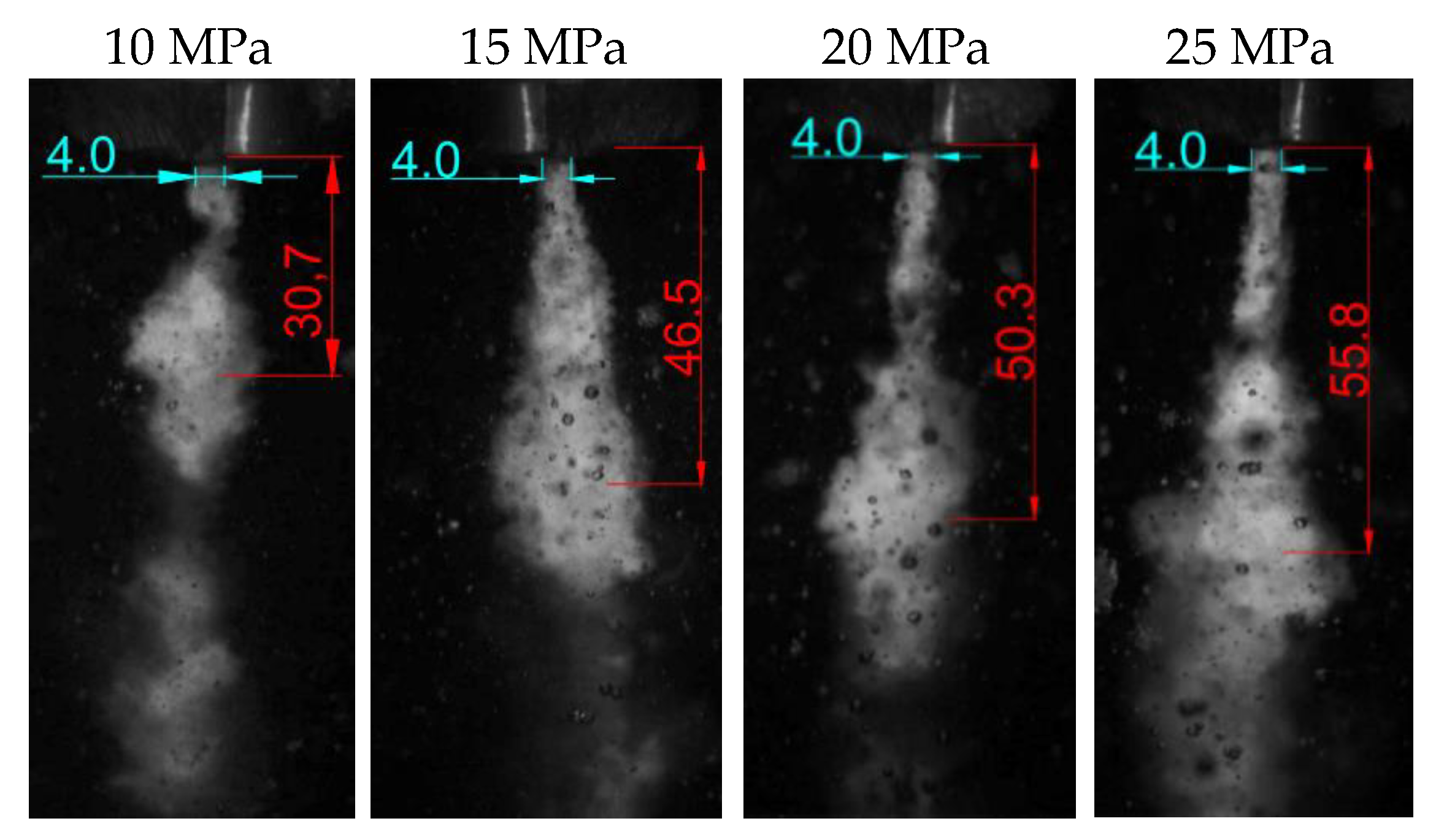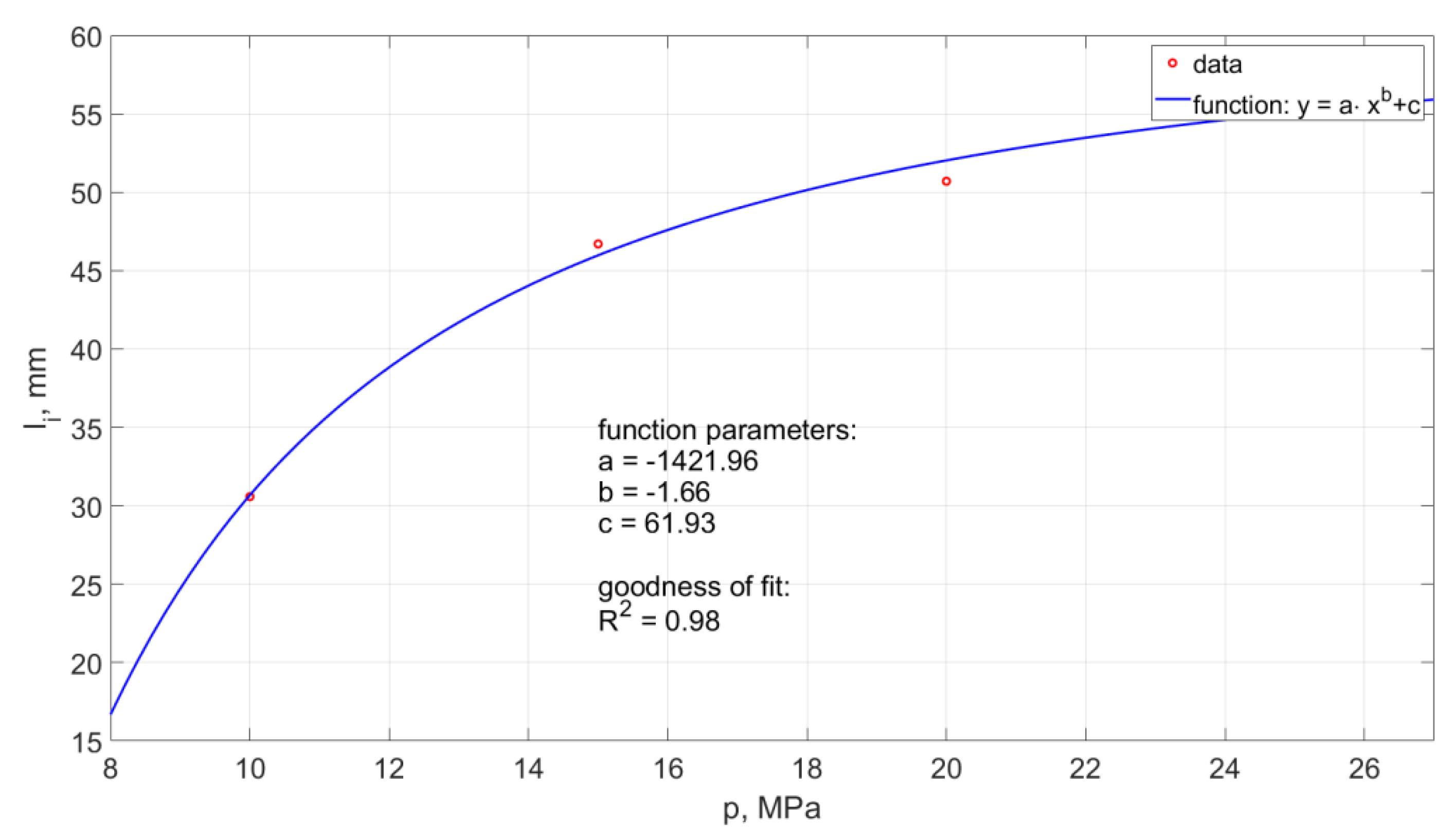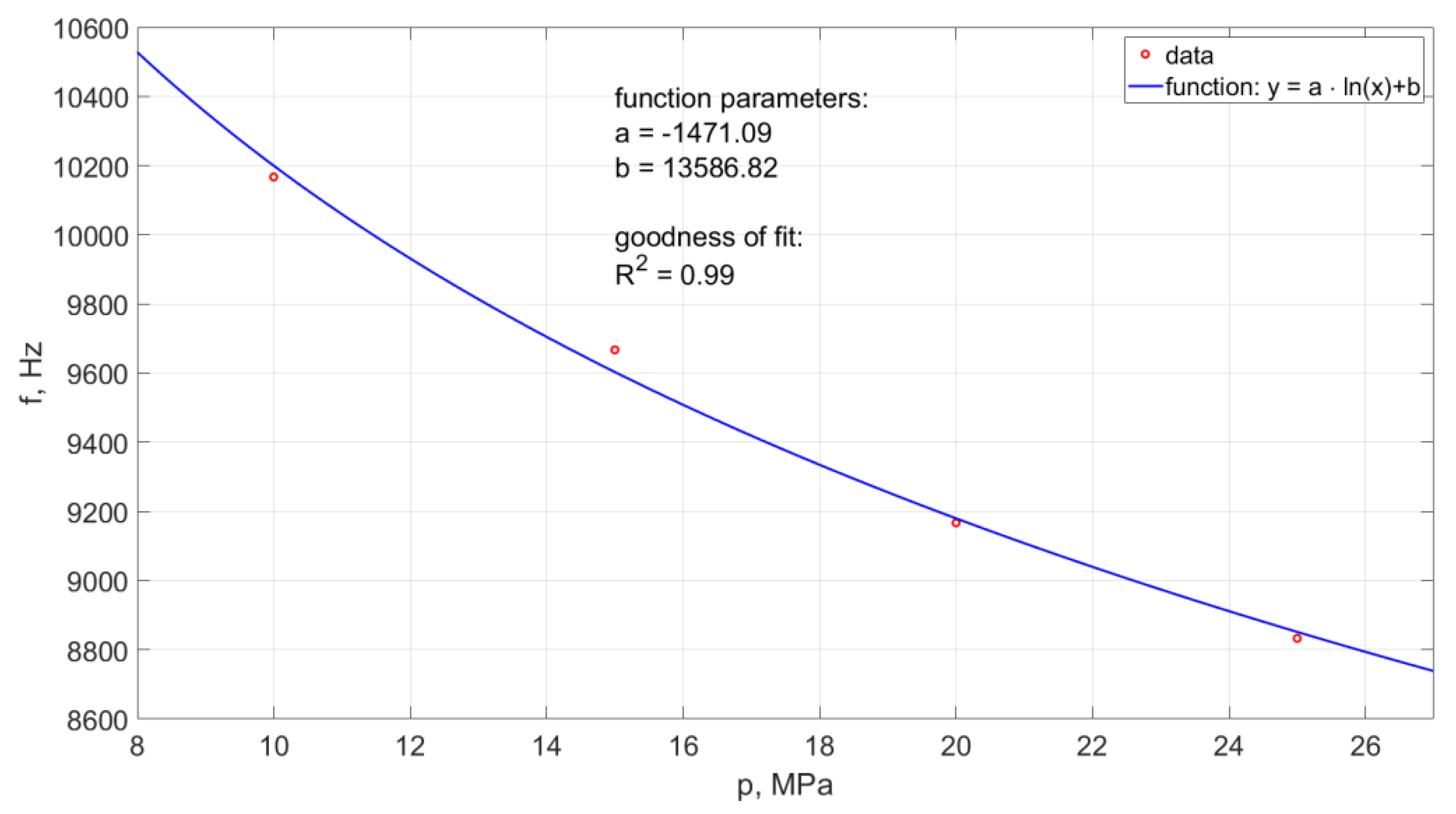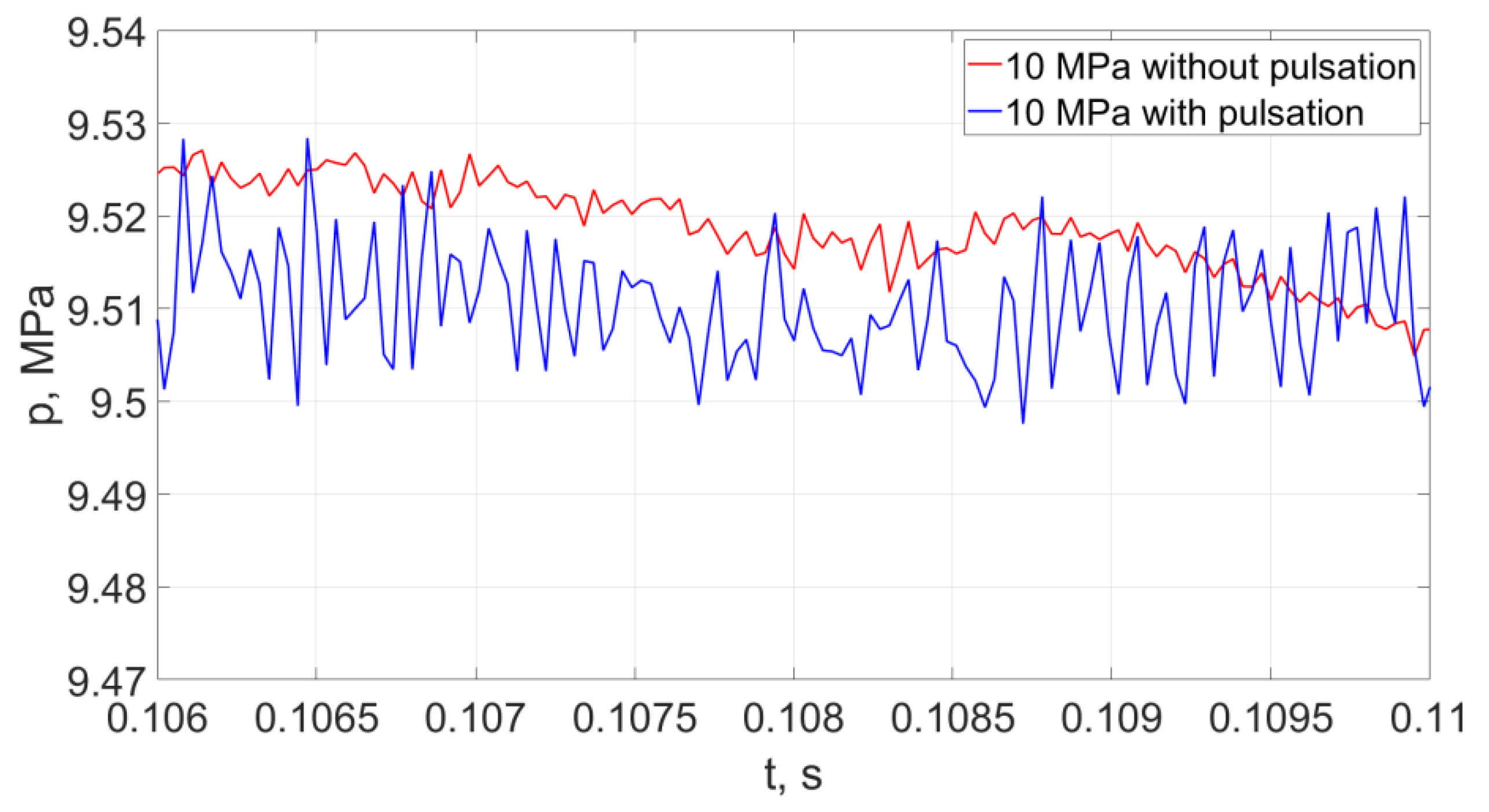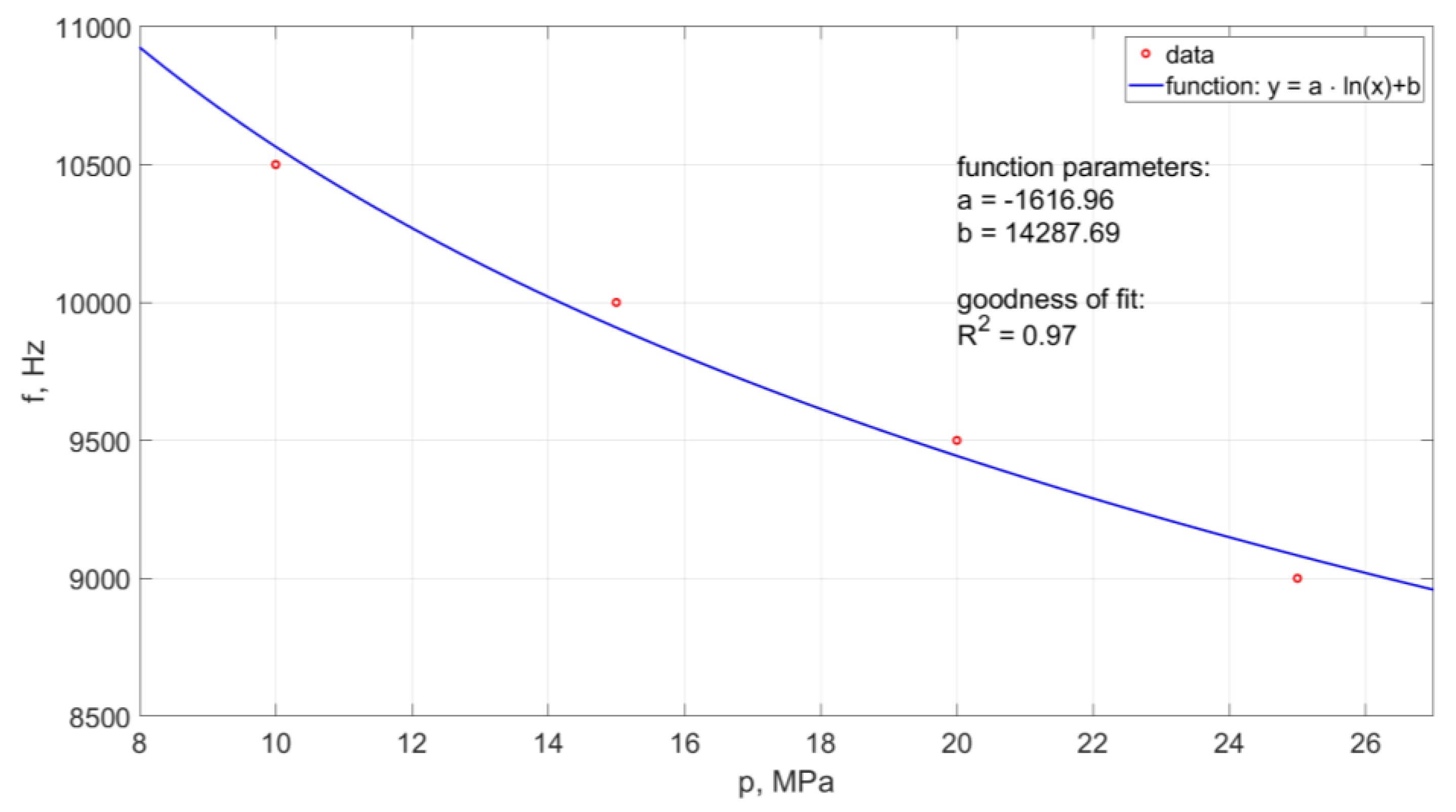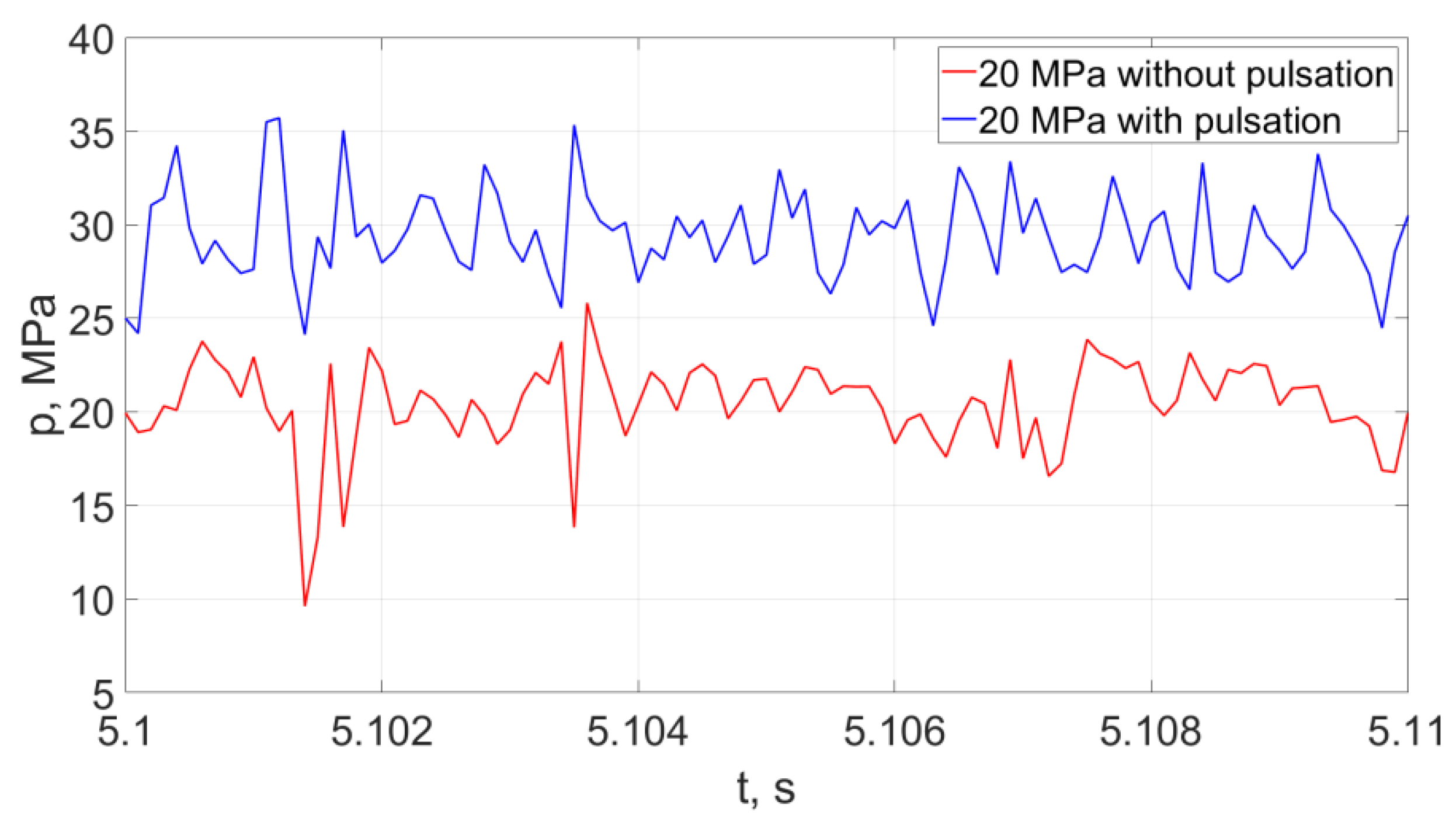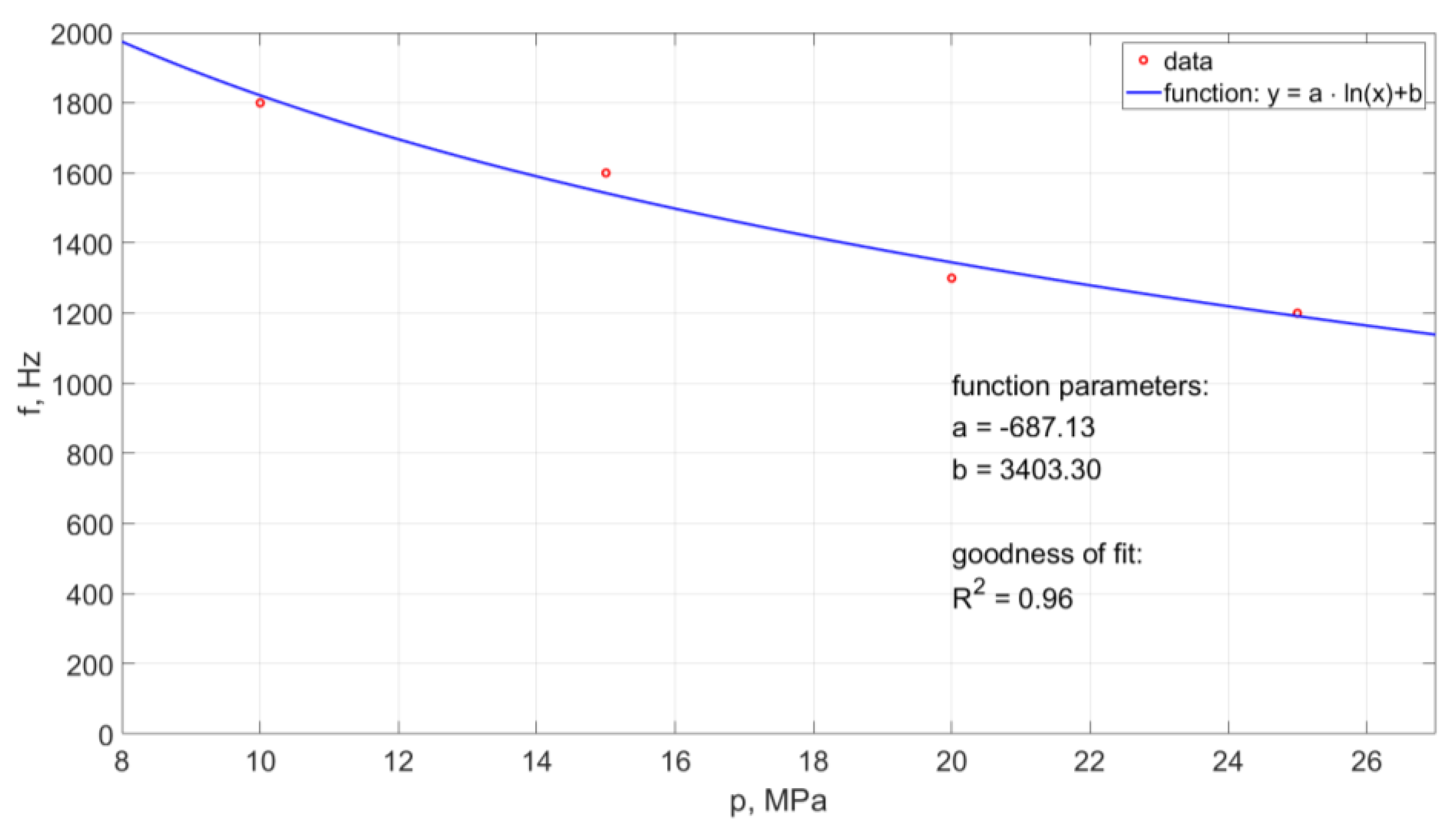Figure 1.
A simplified physical model of the pulse head: a scheme of the construction (a), computer model (b), model after meshing (c).
Figure 1.
A simplified physical model of the pulse head: a scheme of the construction (a), computer model (b), model after meshing (c).
Figure 2.
Differentiation of the geometry of the self-excited pulse head with different locations of the side holes: (a) inclined at an angle of 120° to the axis of the head; (b) tangential to the swirl chamber; (c) perpendicular to the axis of the head.
Figure 2.
Differentiation of the geometry of the self-excited pulse head with different locations of the side holes: (a) inclined at an angle of 120° to the axis of the head; (b) tangential to the swirl chamber; (c) perpendicular to the axis of the head.
Figure 3.
Distribution test results: (a,b) speed and (c) pressure inside the self-excited pulse head with side openings located at an angle of 120° (H = 20 mm, D = 20 mm, d2 = 3 mm, d3 = 5 mm, λ = 110°, h1 = 8 mm), for a nominal pressure of 150 MPa.
Figure 3.
Distribution test results: (a,b) speed and (c) pressure inside the self-excited pulse head with side openings located at an angle of 120° (H = 20 mm, D = 20 mm, d2 = 3 mm, d3 = 5 mm, λ = 110°, h1 = 8 mm), for a nominal pressure of 150 MPa.
Figure 4.
Distribution test results: (a,b) speed and (c) pressure inside the self-excited pulse head with side openings tangent to the swirl chamber.
Figure 4.
Distribution test results: (a,b) speed and (c) pressure inside the self-excited pulse head with side openings tangent to the swirl chamber.
Figure 5.
Distribution test results: (a,b) speed and (c) pressure inside the self-excited pulse head with side openings perpendicular to the swirl chamber.
Figure 5.
Distribution test results: (a,b) speed and (c) pressure inside the self-excited pulse head with side openings perpendicular to the swirl chamber.
Figure 6.
Graphical interpretation of velocity and pressure distributions for selected head solutions with different locations of side openings: (a) inclined at an angle of 120° to the axis of the head; (b) tangential to the swirl chamber; (c) perpendicular to the axis of the head.
Figure 6.
Graphical interpretation of velocity and pressure distributions for selected head solutions with different locations of side openings: (a) inclined at an angle of 120° to the axis of the head; (b) tangential to the swirl chamber; (c) perpendicular to the axis of the head.
Figure 7.
Distribution of velocity vectors: (a) and pressure (b) inside the selected model of the self-excited pulse head at a nominal pressure of 150 MPa.
Figure 7.
Distribution of velocity vectors: (a) and pressure (b) inside the selected model of the self-excited pulse head at a nominal pressure of 150 MPa.
Figure 8.
Graphical interpretation of the distance between the pulse head and the force sensor: (a) for a continuous stream, (b) for a pulsed stream.
Figure 8.
Graphical interpretation of the distance between the pulse head and the force sensor: (a) for a continuous stream, (b) for a pulsed stream.
Figure 9.
Measuring stations for recording images of impulse and continuous water jets operating in the air medium: 1−high-pressure power cord, 2−self-excited pulse head, 3−head mounting bracket, 4−force sensor, 5−lighting, 6−Phantom V12.1 camera.
Figure 9.
Measuring stations for recording images of impulse and continuous water jets operating in the air medium: 1−high-pressure power cord, 2−self-excited pulse head, 3−head mounting bracket, 4−force sensor, 5−lighting, 6−Phantom V12.1 camera.
Figure 10.
Measuring station for testing the water stream produced in a self-excited pulse head working in an aqueous medium: 1−P30 monitor, 2−force sensor mounting, 3−high-pressure hose, 4−water tank, 5−illuminator, 6−force sensor with a KISTLER 9602AQ01 transducer, 7−Phantom V12.1 camera.
Figure 10.
Measuring station for testing the water stream produced in a self-excited pulse head working in an aqueous medium: 1−P30 monitor, 2−force sensor mounting, 3−high-pressure hose, 4−water tank, 5−illuminator, 6−force sensor with a KISTLER 9602AQ01 transducer, 7−Phantom V12.1 camera.
Figure 11.
Stand for testing water jet erosivity: (a) stand diagram: 1−monitor unit, 2−manometer, 3−power cord, 4−self-excited pulse head, 5−workpiece, 6−sliding table, and (b) general view of the stand.
Figure 11.
Stand for testing water jet erosivity: (a) stand diagram: 1−monitor unit, 2−manometer, 3−power cord, 4−self-excited pulse head, 5−workpiece, 6−sliding table, and (b) general view of the stand.
Figure 12.
Images of the formation of hydrodynamic pulses during the operation of the head in the air medium, working at the nominal pressure: (a) 10 MPa, (b) 25 MPa.
Figure 12.
Images of the formation of hydrodynamic pulses during the operation of the head in the air medium, working at the nominal pressure: (a) 10 MPa, (b) 25 MPa.
Figure 13.
Sample images of a pulsating water stream flowing from the outlet nozzle, tested under air conditions, working at the nominal pressure: (a) 10 MPa, (b) 25 MPa.
Figure 13.
Sample images of a pulsating water stream flowing from the outlet nozzle, tested under air conditions, working at the nominal pressure: (a) 10 MPa, (b) 25 MPa.
Figure 14.
Influence of water pressure on the distance between the formation of hydrodynamic impulses and the outlet from a self-excited pulse head operating in the air environment.
Figure 14.
Influence of water pressure on the distance between the formation of hydrodynamic impulses and the outlet from a self-excited pulse head operating in the air environment.
Figure 15.
Results of the formation of hydrodynamic impulses in the water stream during the operation of the head in the water environment, at the input pressure: (a) 10 MPa, (b) 25 MPa.
Figure 15.
Results of the formation of hydrodynamic impulses in the water stream during the operation of the head in the water environment, at the input pressure: (a) 10 MPa, (b) 25 MPa.
Figure 16.
Examples of images of shaping hydrodynamic pulses produced in an aquatic environment.
Figure 16.
Examples of images of shaping hydrodynamic pulses produced in an aquatic environment.
Figure 17.
Influence of water pressure on the distance between the formation of hydrodynamic impulses and the outlet from a self-excited pulse head operating in the water environment.
Figure 17.
Influence of water pressure on the distance between the formation of hydrodynamic impulses and the outlet from a self-excited pulse head operating in the water environment.
Figure 18.
Influence of nominal water pressure on the frequency of pulses recorded with an ultrafast camera, for the head designed for drilling holes working in the air environment.
Figure 18.
Influence of nominal water pressure on the frequency of pulses recorded with an ultrafast camera, for the head designed for drilling holes working in the air environment.
Figure 19.
Influence of the change of nominal water pressure on the frequency of recorded hydrodynamic impulses, produced in a self-excited pulsed head designed for drilling holes, working in the water environment.
Figure 19.
Influence of the change of nominal water pressure on the frequency of recorded hydrodynamic impulses, produced in a self-excited pulsed head designed for drilling holes, working in the water environment.
Figure 20.
Distributions of hydrodynamic impulses occurring in the water stream (with a pressure of 10 MPa at a distance of 50 mm from the outlet from the pulsating head), produced in the head for drilling holes in the air environment and in the “continuous” stream operating under similar conditions.
Figure 20.
Distributions of hydrodynamic impulses occurring in the water stream (with a pressure of 10 MPa at a distance of 50 mm from the outlet from the pulsating head), produced in the head for drilling holes in the air environment and in the “continuous” stream operating under similar conditions.
Figure 21.
Influence of nominal water pressure on the pulsation frequency of the water stream generated in the head designed for drilling holes in the air environment.
Figure 21.
Influence of nominal water pressure on the pulsation frequency of the water stream generated in the head designed for drilling holes in the air environment.
Figure 22.
Distributions of hydrodynamic impulses occurring in the water stream (with a pressure of 20 MPa at a distance of 50 mm from the outlet from the pulsating head), produced in the head for drilling holes in the water environment and in the “continuous” stream operating under similar conditions.
Figure 22.
Distributions of hydrodynamic impulses occurring in the water stream (with a pressure of 20 MPa at a distance of 50 mm from the outlet from the pulsating head), produced in the head for drilling holes in the water environment and in the “continuous” stream operating under similar conditions.
Figure 23.
The waveform of the frequency of hydrodynamic pulses recorded with a force sensor for a self-excited pulse head designed for drilling holes working in an aquatic environment.
Figure 23.
The waveform of the frequency of hydrodynamic pulses recorded with a force sensor for a self-excited pulse head designed for drilling holes working in an aquatic environment.
Figure 24.
Comparison of the eroding depth of aerated concrete with a water jet (pulsating and without pulsation) produced in the drilling head with a feed rate of: (a) 3 mm/s, (b) 6 mm/s.
Figure 24.
Comparison of the eroding depth of aerated concrete with a water jet (pulsating and without pulsation) produced in the drilling head with a feed rate of: (a) 3 mm/s, (b) 6 mm/s.
Table 1.
Ranges of the variability of the investigated geometric parameters for various design solutions of a self-excited pulse head operating at a pressure of 150 MPa.
Table 1.
Ranges of the variability of the investigated geometric parameters for various design solutions of a self-excited pulse head operating at a pressure of 150 MPa.
| Geometric Parameters | Range | Unit |
|---|
| inlet nozzle diameter, d1 | 2.5 | mm |
| inlet nozzle height, h1 | 6; 8;10;12 | mm |
| rake angle of the chamber, λ | 100;110;120 | ° |
| side inlets diameter, d2 | 2;3;4;5;6;7;8 | mm |
| swirl chamber diameter, D | 20;25;30;35;40;45;50 | mm |
| vortex chamber height, H | 20;25;30;35;40;45;50 | mm |
| outlet nozzle diameter, d3 | 4;5;6;7;8;9 | mm |
Table 2.
Characteristics of the geometric dimensions and velocity of the water stream produced in the most favorable models of heads with side openings perpendicular to the swirl chamber.
Table 2.
Characteristics of the geometric dimensions and velocity of the water stream produced in the most favorable models of heads with side openings perpendicular to the swirl chamber.
| | Models of Heads with Side Openings Perpendicular to the Swirl Chamber |
|---|
| Parameter | Designation | (a) | (b) | (c) |
|---|
| inlet nozzle diameter, mm | d1 | 2.5 | 2.5 | 2.5 |
| inlet nozzle height, mm | h1 | 12 | 12 | 10 |
| rake angle of the chamber, ° | λ | 120 | 110 | 120 |
| side inlets diameter, mm | d2 | 2 | 6 | 2 |
| swirl chamber diameter, mm | D | 25 | 32 | 30 |
| swirl chamber height, mm | H | 15 | 25 | 20 |
| outlet nozzle diameter, mm | d3 | 4 | 7 | 4 |
| average speed at outlet, m/s | υavg. | 264 | 224 | 242 |
| maximum speed at inlet, m/s | υmax | 590 | 556 | 561 |
| speed ratio, % | υśr/υmax | 44.7 | 40.3 | 43.1 |
Table 3.
Characteristics of the geometric dimensions and velocity of the water stream produced in the heads optimal in terms of the location of the side holes.
Table 3.
Characteristics of the geometric dimensions and velocity of the water stream produced in the heads optimal in terms of the location of the side holes.
| Parameter | Designation | Side Openings at an Angle of 120° to the Head Axis | Side Openings Tangent to the Swirl Chamber | Side Openings Perpendicular to the Swirl Chamber |
|---|
| swirl chamber diameter, mm | D | 25 | 30 | 25 |
| swirl chamber height, mm | H | 30 | 30 | 15 |
| rake angle of the swirl chamber, ° | λ | 100 | 120 | 120 |
| inlet nozzle height, mm | h1 | 8 | 6 | 12 |
| inlet nozzle diameter, mm | d1 | 2.5 | 2.5 | 2.5 |
| side inlets diameter, mm | d2 | 3 | 2 | 2 |
| outlet nozzle diameter, mm | d3 | 6 | 4 | 4 |
| average speed at outlet, m/s | υavg. | 113 | 279 | 264 |
| maximum speed at inlet, m/s | υmax | 561 | 589 | 590 |
| speed ratio, % | υśr/υmax | 20.1 | 47.4 | 44.7 |
Table 4.
Geometric parameters of the self-excited pulse head taken into account during the optimization process of the selected solution.
Table 4.
Geometric parameters of the self-excited pulse head taken into account during the optimization process of the selected solution.
| Lp | Parameter | Designation | Range |
|---|
| 1 | width of the annular surfaces of the swirl chamber, mm | SP | 1 ÷ 6 |
| 2 | outlet nozzle height, mm | h3 | 4 ÷ 24 |
| 3 | swirl chamber diameter, mm | D | 25 ÷ 50 |
| 4 | vortex chamber height, mm | H | 15 ÷ 35 |
| 5 | inlet nozzle height, mm | h1 | 6 ÷ 12 |
| 6 | rake angle of the swirl chamber, ° | λ | 100 ÷ 120 |
| 7 | outlet nozzle diameter, mm | d3 | 4 ÷ 9 |
| 8 | side holes diameter, mm | d2 | 2 ÷ 5 |
| 9 | inlet nozzle diameter, mm | d1 | 2 ÷ 3.2 |
Table 5.
Selected dimensional parameters of the selected model of a self-excited pulsation head intended for drilling holes with a water jet for pressures from 15 MPa to 150 MPa.
Table 5.
Selected dimensional parameters of the selected model of a self-excited pulsation head intended for drilling holes with a water jet for pressures from 15 MPa to 150 MPa.
| Lp | Parameter | Designation | Value |
|---|
| 1 | swirl chamber diameter, mm | D | 25 |
| 2 | swirl chamber height, mm | H | 15 |
| 3 | inlet nozzle height, mm | h1 | 12 |
| 4 | rake angle of the swirl chamber, ° | λ | 120 |
| 5 | outlet nozzle diameter, mm | d3 | 4 |
| 6 | side holes diameter, mm | d2 | 2 |
| 7 | inlet nozzle diameter, mm | d1 | 2.5 |
| 8 | width of the annular surfaces of the swirl chamber, mm | SP | 6 |
Table 6.
Selected dimensional parameters of the selected model of a self-excited pulsation head intended for drilling holes with a water jet for pressures from 15 MPa to 150 MPa.
Table 6.
Selected dimensional parameters of the selected model of a self-excited pulsation head intended for drilling holes with a water jet for pressures from 15 MPa to 150 MPa.
| Lp. | Pressure P, MPa | Pulse Formation Distance li, mm | The Average Distance of the Formation of the Pulses, mm |
|---|
| 1 | 10 | 24.44 | 25.44 | 24.96 | 25.45 | 25.1 | 25.08 |
| 2 | 15 | 35.85 | 35.22 | 35.81 | 35.82 | 35.72 | 35.68 |
| 3 | 20 | 41.97 | 41.23 | 41.51 | 40.98 | 41.02 | 41.34 |
| 4 | 25 | 41.57 | 42.51 | 42.33 | 41.52 | 42.58 | 42.10 |
Table 7.
Measurements of the distance between the shaping of hydrodynamic impulses in the water stream flowing from the outlet nozzle of the head intended for drilling holes, working in the water environment.
Table 7.
Measurements of the distance between the shaping of hydrodynamic impulses in the water stream flowing from the outlet nozzle of the head intended for drilling holes, working in the water environment.
| lp. | Pressure p, MPa | Pulse Formation Distance li, mm | The Average Distance of the Formation of the Pulses, mm |
|---|
| 1 | 10 | 30.7 | 31.1 | 30.8 | 30.2 | 30.1 | 30.58 |
| 2 | 15 | 46.5 | 46.2 | 47.1 | 46.8 | 46.9 | 46.70 |
| 3 | 20 | 50.3 | 50.8 | 50.2 | 51.3 | 50.9 | 50.70 |
| 4 | 25 | 55.8 | 56 | 56.2 | 55.4 | 55.6 | 55.80 |

